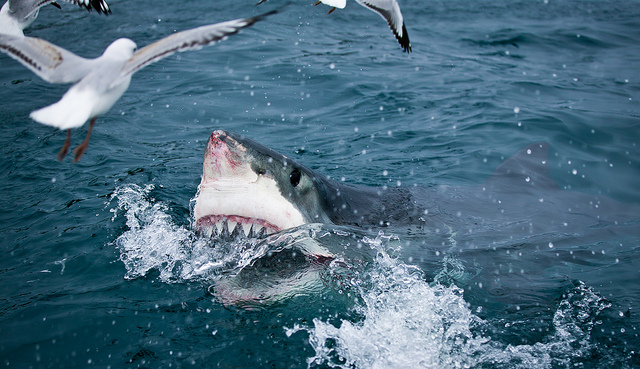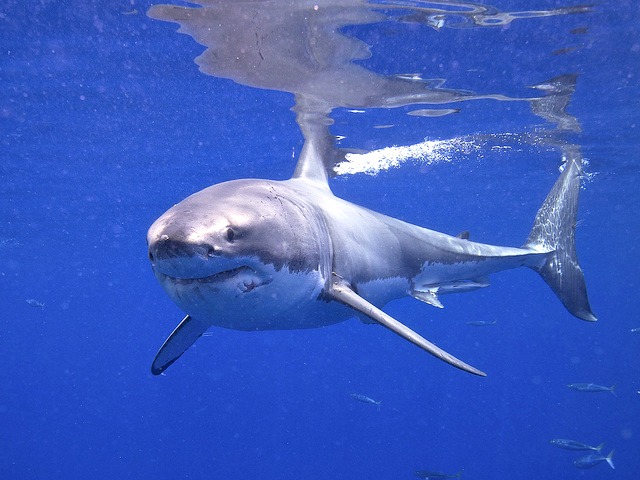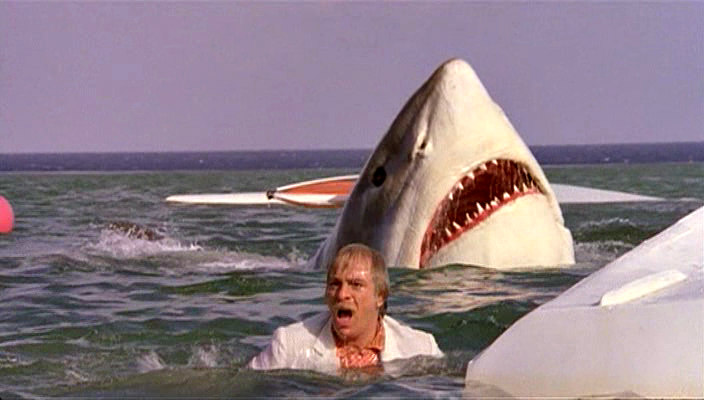10 Facts About Great White Sharks
Many people think of the great white shark as a scary creature. After all, it has those big teeth and it does have a reputation for chomping at humans. However, the things that make the great white shark frightening are also the things that make it amazing. Indeed, the great white shark is one cool animal (even though it is partly warm-blooded). It’s shaped like a torpedo. It’s older than dinosaurs. It’s heavier than a car. It has a mouth big enough to swallow a seal whole. Want to learn more? Below are ten more cool facts about great white sharks.
1. They can grow over 17 feet (5.2 meters) long.

Great white sharks are not the largest sharks. That title belongs to the whale shark. Still, they can grow 13 to 20 feet (4 to 6 meters) on average — longer than a pick-up truck — and weigh more than 5000 pounds (2268 kilograms).
As for the largest great white shark, there are several reports. Some say it was 21 feet (6.4 meters) long and weighed over 7000 pounds (3175 kilograms). Others claim it was 23 feet (7 meters) long. The largest confirmed specimen, though, was 17.9 feet (5.5 meters) long.
Like many large animals, great white sharks live a long time — up to 70 years. They grow slowly, though, and are only able to reach their full size between 25 and 35 years of age.
2. They go through more than 1000 teeth in their lifetime.

Let’s talk about something more fearsome than the great white shark’s size — its teeth. The great white shark can have 300 teeth arranged in seven rows at any time in their life, each pointed, razor-sharp and up to 3 inches (7.6 centimeters) long. These teeth aren’t very strong, though. In fact, they come off easily. When they do, the great white shark eats the broken tooth whenever possible, in order to reuse the calcium.
Why then, don’t you see a great white shark with a gap in its teeth? Because when a tooth falls off, the rest of the teeth move forward to fill up the space. As for the space left at the back, it doesn’t remain empty for long, because a new tooth grows within the day. And that’s how the great white shark can go through a thousand teeth or more in a lifetime, and without a single trip to the dentist.
Speaking of dentists, while great white sharks regularly lose teeth, they never get tooth decay. Their teeth are not only very hard, but also coated in an acid-resistant chemical. It’s like having their own built-in, permanent toothpaste. Cool, huh?
3. They have no bones.

In spite of having so many teeth, great white sharks do not have any bones. That’s one reason why their teeth fall off easily – because the teeth are not attached to bones like ours are. Instead, the skeleton of a great white shark is made up of cartilage. Cartilage is tough tissue. How tough? Just try taking off your ear or your nose. Those are made of cartilage, too. Cartilage might not be as hard as bone, but it is still durable. More importantly, it is light and flexible, allowing the shark to swim quickly and smoothly.
4. They can smell a single drop of blood in a billion drops of water.

As top predators, great white sharks are equipped with killer senses. They have good eyesight, good hearing and an excellent sense of smell. In fact, scientists believe they can smell blood, even if there were just a single drop of it in an Olympic-sized swimming pool, and they can even smell it up to 3 miles (4.8 kilometers) away.
Because their noses are so sensitive, it is a good idea to hit a great white shark on the nose in case one tries to attack you. This will make it dizzy for a bit and make it think twice about wanting to eat you. And if it still wants to eat you, at least you’ll have gotten some time to get away. Hitting a great white shark’s eyes or gills is a good idea, too, or even better, since they’re farther away from the shark’s deadly teeth.
5. And they have a sixth sense.

Most of the time, however, great white sharks do not find food using their sense of smell, or any of the five senses we’re used to. Rather, they use their sixth sense — electroreception.
Great white sharks have special organs called ampullae of Lorenzini. See the dark spots around a great white shark’s face? Those are the pores that lead to the ampullae of Lorenzini, which are filled with a jelly-like substance. These organs can sense the electromagnetic field given off by all living creatures when they move, even us humans. Even if it’s just as weak as half a billionth of a volt, the great white shark senses it and swims toward it, ready for its next meal.
6. They like to roll their eyes.

And it’s not because they’re annoyed or frustrated. Rather, great white sharks roll their eyes to the back of their heads whenever they attack, so they don’t actually see what they’re attacking, in order to protect their eyes from getting damaged. They don’t have eyelids, after all, like we do. When someone tries to hurt your eyes, by throwing sand at you, for example, you instinctively close your eyes to protect them, but since great white sharks can’t close their eyes, they roll them back instead. Most animals they pursue, after all, don’t go down without a fight and during the fight, the great white shark can get hurt. In fact, many great white sharks have scars left behind by their previous attempts at meals. Wounds may heal but if a great white shark is blinded, it will never get its eyesight back and will have a hard time finding food in the future.
7. And they like to spy.

If you thought a great white shark simply grabs whatever moving creature it comes across, think again. Great white sharks are actually one of the few sharks that like to investigate their prey first. They lift their heads above the water’s surface and give a good look around. This habit is known as spy-hopping.
8. They have to keep moving.

Remember Dory’s mantra, “Just keep swimming”? Well, great white sharks actually have to live by this, literally. This is because great white sharks breathe by a process called ram ventilation. As they swim along, the water “rams” into their mouths, and they let it out through their gill slits, to extract the oxygen they need. Therefore, if they stop moving, they’ll stop breathing and they will die.
Killer whales know this well, and so will often hold a great white shark still to kill it. Also, for this reason, great whites are very difficult to keep in captivity. The need to move constantly and the knowledge that they have limited space to move around in makes them restless and oftentimes leads to their death.
If great white sharks need to keep moving, then, how do they sleep? Research shows that they actually get some winks (not literally, since sharks sleep with their eyes open — no eyelids, remember?) It is their spinal cord that regulates their movement, not their brain, so they can shut down their brains and still keep swimming.
9. They eat just about anything.

Now, this you probably already know. Great white sharks aren’t picky eaters. They will eat fish, including other sharks, though they prefer tuna, as well as dolphins, whales, seals, sea lions, sea otters, sea turtles and seabirds. They also sometimes eat crocodiles and sea snakes. Non-edible objects, such as human trash and boat parts, have been found in their stomachs, as well. They can eat up to a quarter of their body weight in just one meal and afterward, they can go without food for weeks.
10. They are responsible for the most attacks on humans.

Alright, here comes the scary part — great white sharks are responsible for the greatest number of human attacks, or at least, so the records say. According to the records, the great white shark attacked 279 humans without provocation in the past 400 years, and killed 78 of them.
In spite of this number, scientists insist that the great white shark has been painted as a villain unfairly. There is an even greater chance that you will get bitten by a dog or even get struck by lightning than of getting attacked by a great white shark.
Now, is that cool or what?
Also see:
12 Adaptations of the Great White Shark
Why Do Great White Sharks Attack Humans?
Great White Shark Facts!
Sources:
http://en.wikipedia.org/wiki/Great_white_shark
http://sharkfacts.org/great-white-shark-facts/
http://www.livescience.com/27338-great-white-sharks.html
http://animals.nationalgeographic.com/animals/fish/great-white-shark/





coo
thees wos soo awesomeoo one loooked loke broce from findend neemoo
İm using this for my homework.
if you think about the number of people who haven’t been killed, just hurt, 201 people, and then 78 killed, that’s over 400 years.
My favorite animal is ????????????????????
The great white shark do not attack the human because they don’t like human meet it test bad for them. But it’s good
you have such a horrible grammar
Realyyyyyyyyy wierddddddddddddd
super cool
It is so big
This is so cool
i know, right?!
this is weird but i like it
one does not look like a shark
I like it
so cool
this is asome cool